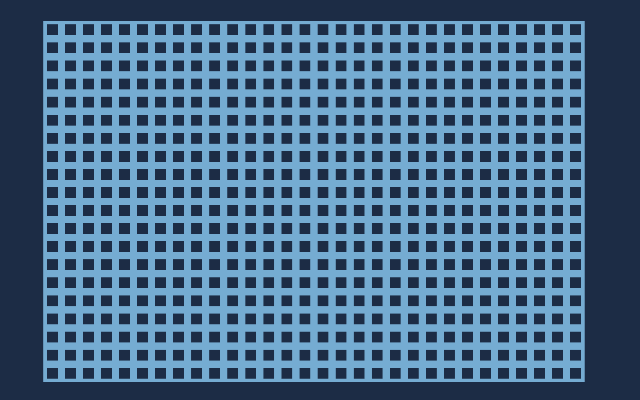源起
一直以来我都认为算法是编程中的灵魂,也许有人认为没有算法一样能够写出可以运行的程序。但对于写出好的程序,并认识到为什么好,没有算法的知识就是经验主义的瞎摸索。由于我又是个半路出家的游戏程序,计算机基础实在薄弱,想要在这个方面补充些知识,阅读像《算法》、《算法导论》这样的算法书是一方面,另一方面想要学习一些算法在工程中的实际使用(虽然也没那么工程)。于是,这个游戏算法的系列就是为此而生,记录在算法实践中的思路和资料整合。因为工作原因,主力工具是Unity,所以大部分的代码是在Unity中完成的,会有一些Unity组件的加入。
迷宫生成算法
作为一个Roguelike游戏的爱好者,我对于所有的程序生成(内容)技术都非常感兴趣。在学习游戏程序之前甚至还学了点深度学习(非常皮毛,基本上是当作工具在用,当然现在基本快忘光了…捂脸)。作为Roguelike游戏的基础,地图生成就成为了不二之选。而且Wiki也有详细的介绍。
根据Wikipedia的Maze generation algorithm条目,有如下迷宫生成算法:
- 基于图论的算法
- 深度优先搜索 Depth-first Search
- 递归回溯 Recursive Backtracker
- 随机Kruskal算法 Randomized Kruskal’s Algorithm
- 随机Prim算法 Randomized Prim’s Algorithm
- 递归分割算法 Recursive Division
- …
这篇文章中的迷宫是使用的单元是周围有墙的,也就是说和周边单元的连通性存储在单元内(当然这样会有重复的数据)。后面的章节也许会修改成墙作为单独的单元存在(大部分的Roguelike游戏也是这样做的)。
深度优先
从任意一个起点(或者指定单元)开始,随机选择一个邻近的单元,将这个单元设置为已访问,然后把这个单元设置为当前单元。重复上面的步骤,直到当前单元没有未访问的邻近单元。然后重新选择未访问的单元,重复步骤。 按照wiki上的深度优先的解释,似乎和递归回溯是一样的。不过看旁边的图的似乎有的路径没有和主路径连通(即不是完美迷宫),所以差别应该在一条路径走到尽头,然后选取第二个点重开路径上。
递归回溯
全称是使用递归回溯的深度优先算法,深度优先的加强版。区别在于每次更新当前单元的时候,会把上一个单元作为节点存储到一个栈中,这样当一个路径到死路时,从栈顶取出单元作为当前单元,如果当前单元没有未访问的邻近单元,再取出下一个栈顶,这称为“递归回溯”。
Wiki的流程说明(翻译请见核心循环段落):
- Make the initial cell the current cell and mark it as visited
- While there are unvisited cells
- If the current cell has any neighbours which have not been visited
- Choose randomly one of the unvisited neighbours
- Push the current cell to the stack
- Remove the wall between the current cell and the chosen cell
- Make the chosen cell the current cell and mark it as visited
- Else if stack is not empty
- Pop a cell from the stack
- Make it the current cell
随机Kruskal算法
随机Kruskal算法看起来像是随机选择某个单元和它随机的邻近的单元连结(去除中间的墙)。
- Create a list of all walls, and create a set for each cell, each containing just that one cell.
创建所有墙的列表,并且创建所有单元的集合,每个集合中只包含一个单元。- For each wall, in some random order:
以随机的顺序选取每一个墙:
- If the cells divided by this wall belong to distinct sets:
如果被当前的墙分隔的两个单元属于不同的集合:
- Remove the current wall.
去除当前的墙。- Join the sets of the formerly divided cells.
把单元加入到之前分隔的单元。
唔…没有仔细研究,不知道怎么确保连通性的。看上去生成的迷宫比较支离破碎,有很多那种在路口就能一眼看穿的死路。
随机Prim算法
- Start with a grid full of walls.
创建全是墙的网格。- Pick a cell, mark it as part of the maze. Add the walls of the cell to the wall list.
选取一个单元,标记为迷宫路线。将这个单元的墙加入到墙的列表。- While there are walls in the list:
(循环)当列表中还有墙的时候:
- Pick a random wall from the list. If only one of the two cells that the wall divides is visited, then:
从列表中随机选择一个墙,如果墙两边的单元只有一个被访问过,那么:
- Make the wall a passage and mark the unvisited cell as part of the maze.
移除墙,变成通道,把未访问的单元标记未迷宫路线。- Add the neighboring walls of the cell to the wall list.
把这个单元的邻墙加入到墙的列表。- Remove the wall from the list.
从列表中把墙移除。
Prim算法生成的迷宫和Kruskal生成的算法有点类似,非常多短小的支线。和深度优先比起来没有明显的主要路线,走起来会更加困难。
递归分隔算法
递归分隔算法把整个迷宫单元分成数个子迷宫,子迷宫之间生成通路。然后继续把小迷宫分隔直到不能分隔为止。 递归分隔算法生成的迷宫看上去更适合有明显区域概念的游戏,比如去掉一些小迷宫中的墙可以生成大的房间(关于生成带有小房间的迷宫之后应该会写一篇的吧,不过可能不会用递归分隔来做)。
递归生成迷宫实例
上面都是流程步骤,我比较喜欢递归回溯生成的迷宫,嗯,比较好看。所以我把递归回溯的迷宫的详细代码写在下面。
由于在Unity中工作,我把逻辑和表现分开了,表现层只负责初始化和迷宫展示。首先定义迷宫的单元:
// 迷宫单元,存储迷宫单元的数据
public class Cell
{
// 四周的连通性: 0 上, 1 下, 2 左, 3 右
public bool[] links = new bool[4];
// 到开始点最近路线的上一个点,生成迷宫路线用的
public Point? LastCell = null;
// 当前点到起点的距离,后面A*算法中会使用
public int Gweight = int.MaxValue;
/// <summary>
/// 设置连通性
/// </summary>
public void SetLink(Dir dir)
{
links[(int) dir] = true;
}
}
ps:后来发现方向还是顺时针写比较好,不容易出错,后面在显示层旋转图片的时候吃了点亏,不过算了,有机会再改。
整型坐标
由于Vector2是浮点型的,为了方便计算,写了一个Point类型,相当于一个整型的Vector2.
public enum Dir
{
Up = 0,
Down = 1,
Left = 2,
Right = 3,
}
// 定义一个整型的Point2
public struct Point
{
public int x;
public int y;
public Point(int x, int y)
{
this.x = x;
this.y = y;
}
public void Add(Point point)
{
this.x += point.x;
this.y += point.y;
}
public static Point operator +(Point a, Point b)
{
return new Point(a.x + b.x , a.y + b.y);
}
public static Point operator -(Point a, Point b)
{
return new Point(b.x - a.x, b.y - a.y);
}
public static bool operator ==(Point a, Point b)
{
return a.x == b.x && a.y == b.y;
}
public static bool operator !=(Point a, Point b)
{
return a.x != b.x || a.y != b.y;
}
public static Point Up()
{
return new Point(0, 1);
}
public static Point Down()
{
return new Point(0, -1);
}
public static Point Left()
{
return new Point(-1, 0);
}
public static Point Right()
{
return new Point(1, 0);
}
public static Point[] DirPoints = new Point[] {Point.Up(), Point.Down(), Point.Left(), Point.Right()};
public override string ToString()
{
return string.Format("({0}, {1})", x, y);
}
}
迷宫创建器
重头戏当然是迷宫创建器,参考Wiki对递归回溯的说明。
为了方便做展示动画,创建方法写成了协程,每一帧访问一个单元,并在结束的时候执行结束方法(这里其实只是把走迷宫的按钮显示出来)。
public IEnumerator CreatMazeWithAnima(Action<Cell[,]> args = null)
{
// 初始化
cells = new Cell[Width, Height];
MarkedArr = new bool[Width, Height];
// 初始化初始坐标
curIndex = StartPoint;
// 访问过的格子栈
cellStack = new Stack<Point>();
// 随机选择下一步的时候用的单元列表
CellForSelect = new List<Dir>();
// 初始化单元
for (int i = 0; i < Width; i++)
{
for (int j = 0; j < Height; j++)
{
cells[i, j] = new Cell();
}
}
// 主循环,如果还有单元没被标记为访问过,从当前的单元开始检查
while (!CheckAllMarked())
{
CheckCurCell(curIndex);
yield return null;
}
// 执行完成方法
if (args != null)
args(cells);
}
核心循环
按照Wiki的流程说明,
- 如果当前的单元有没有访问过的邻单元
- 随机选择邻单元
- 将当前单元加入栈
- 移除选择的单元和当前单元之间的墙
- 把选择的单元标记为当前单元并标记为已访问
- 如果当前单元没有未访问的邻单元
- 从栈顶去除一个单元
- 标记为当前单元
- 循环
为了展示过程,在每次修改的单元的时候使用Action委托,调用了显示层的方法。
public List<Dir> CellForSelect;
public Point[] dirPoints = new Point[4] {new Point(0, 1), new Point(0, -1), new Point(-1, 0), new Point(1, 0)};
public Dir[] dirs = new Dir[4] { Dir.Up, Dir.Down, Dir.Left, Dir.Right };
public Dir[] antiDirs = new Dir[4] { Dir.Down, Dir.Up, Dir.Right, Dir.Left };
private readonly System.Random rand = new System.Random();
public void CheckCurCell(Point curPoint)
{
// 标记当前单元
MarkedArr[curPoint.x, curPoint.y] = true;
// 检查周边元素
CheckNearbyMarked(curPoint);
if (CellForSelect.Count != 0)
{
// 如果存在未访问的单元
int nextPoint = rand.Next(0, CellForSelect.Count);
// 当前元素入栈
cellStack.Push(curPoint);
// 移除当前单元墙壁
cells[curPoint.x, curPoint.y].SetLink(CellForSelect[nextPoint]);
// 移除目标单元墙壁
Point target = curPoint + dirPoints[(int)CellForSelect[nextPoint]];
//Debug.Log(curPoint + " " + CellForSelect[nextPoint]);
cells[target.x, target.y].SetLink(antiDirs[(int)CellForSelect[nextPoint]]);
// 修改图片的Action,在创建Creator的时候给Action赋值
SetLinkAct(cells[curPoint.x, curPoint.y], curPoint);
SetLinkAct(cells[target.x, target.y], target);
// 目标单元作为当前单元
curIndex = target;
}
else if(cellStack.Count != 0)
{
curIndex = cellStack.Pop();
}
else
{
Debug.LogError("Something wrong");
Assert.IsTrue(true);
}
}
/// <summary>
/// 是否全部被标记
/// </summary>
public bool CheckAllMarked()
{
for (int i = 0; i < MarkedArr.GetLength(0); i++)
{
for (int j = 0; j < MarkedArr.GetLength(1); j++)
{
if (!UseCells[i, j]) continue;
if (!MarkedArr[i, j]) return false;
}
}
return true;
}
/// <summary>
/// 判断周边是否被标记
/// </summary>
public List<Dir> CheckNearbyMarked(Point index)
{
CellForSelect.Clear();
for (int q = 0; q < 4; q++)
{
Point targetPIndex = index + dirPoints[q];
// 判断越界
if(targetPIndex.x < 0 || targetPIndex.x >= Width) continue;
if(targetPIndex.y < 0 || targetPIndex.y >= Height) continue;
if (!UseCells[targetPIndex.x, targetPIndex.y]) continue;
if (!CheckMarked(targetPIndex)) CellForSelect.Add(dirs[q]);
}
return CellForSelect;
}
public bool CheckMarked(Point point)
{
return MarkedArr[point.x, point.y];
}
private int b2int(bool x)
{
return x ? 1 : 0;
}
动画效果
这样,就可以生成一个还看得过去的迷宫了。

完整的代码可以在 GithubRepo 中找到。
参考资料:
如有错误或者遗漏,欢迎联系指正。
唯一指定联系邮箱:xysjoshua@hotmail.com